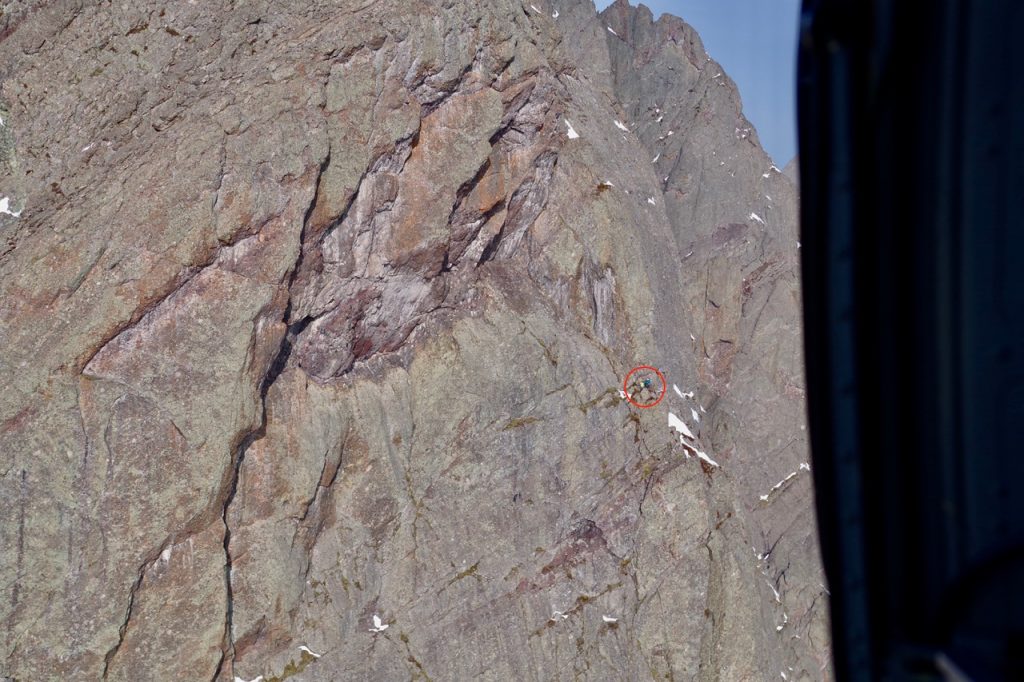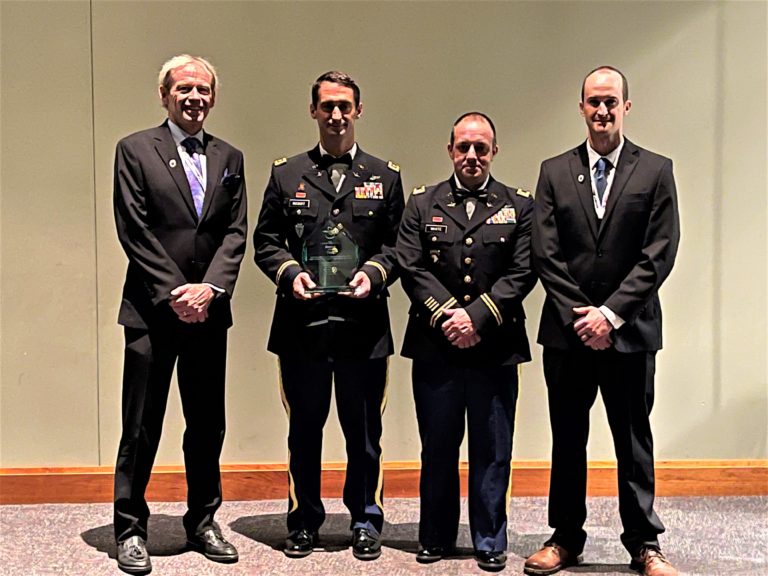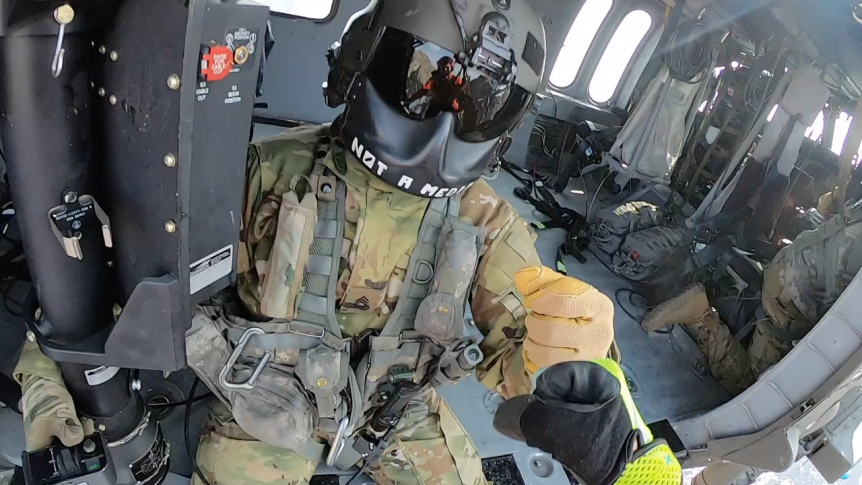By Rick Lindfors, Meridian editor-in-chief (re-printed with permission from the winter 2022 edition of Meridian, the Mountain Rescue Association newsletter)

Members of the Colorado Hoist team received a special honor this year for an impressive rescue done with members of the Colorado National Guard. The team rescued an injured climber from Crestone Needle in September 2020 by doing a hoist rescue from a Blackhawk Helicopter. The members involved received the rescue of the year award from the Dustoff Association, a group that recognizes and supports MEDEVAC personnel in the armed forces. This was the first time the award was given to civilian rescuers. While the award is impressive, the team is building a legacy that will likely impact the broader armed forces as well as civilian rescue teams.
The Colorado Hoist Rescue Team was formed in 2016 with members of Colorado Mountain Rescue teams and the Colorado National Guard with the goal of rescuing people in remote and difficult areas. Army Chief Warrant Officer Clayton Horney sparked the idea, according to CHRT team member and Alpine Rescue Team member Michael Everist. Some of the early meetings to establish the team happened over lunch. “A lot of this started, believe it or not, at TGI Friday’s,” said Everist. A similar program already existed between Colorado Army National Guard High-Altitude ARNG Aviation Training Site, Mountain Rescue Aspen and Vail Mountain Rescue. CHRT now comprises the Colorado National Guard, Alpine Rescue Team, Rocky Mountain Rescue Group, Mountain Rescue Aspen and Vail Mountain Rescue working out of two bases in the state. CW3 Horney brought the necessary players together to establish procedures and guidance. Colonel William Gentle then brought the idea to command staff. “We got approval on a lot of pieces of equipment we wanted to use, but were not necessarily Army standard,” said Everist.
Since the team’s foundation, other elements of the Army started to take notice of not just the equipment, but also the tactics. Most notable is the use of dynamic hoisting. Static hoisting, where a helicopter is stationary while lifting a patient, creates the risk of a litter spinning in the rotorwash from the chopper. A tagline is needed to prevent this happening. A recent example of this going wrong was the rescue of an Arizona woman in June of 2019 that saw the litter spinning rapidly underneath the helicopter. This incident sparked nationwide conversation about helicopter rescue operations and procedures. Dynamic hoisting involves the helicopter moving slowly forward (five to ten knots) while lifting the patient. With the movement, the rotorwash is behind the aircraft and the patient, lowering the risk of spinning. The method is not only safer, but faster. Dynamic hoisting was already practiced by European agencies. With CHRT’s success in the practice, other elements of the army have noticed, and are starting to use it.
The unit trains regularly. They do a hoist every 90 days to maintain currency. There are also various other training events, including multi-day events twice a year. Other agencies such as Flight for Life and Colorado Division of Fire Prevention and Control also take part in meetings with the team.
“It had a slow but steady start,” said Everist, “We continue to build […] I think the speed has been about right.”
Fast forward to September of 2020 and the injured climber on Crestone Needle, which summits at more than 13,000 feet. Days before the rescue, a snowstorm hit the area, with some ice lingering around the summit afterwards. A pair of climbers were on a technical route when one of them took a 30-foot fall on a near-vertical face. He hit a ledge just as his rope went taught. The initial emergency reports indicated the climber had suffered a broken ankle. After considering their options, responders made the call to do a hoist rescue, with a Colorado National Guard Blackhawk helicopter taking off from Buckley air base near Denver the next morning. The climbers spent the night on the ledge, which was only about the size of a dining room table. Only one person could lie down at a time, and the two tried to lay on top of each other to keep each other warm.
On board with the helicopter crew were Alpine Rescue Team members Dale Atkins and Michael Griffin. “I just happened to have my GoPro and didn’t screw it up capturing the footage,” said Atkins.

The warm weather challenged the rescue crew on their first attempt. It was a warm day with lower air pressure, meaning the helicopter couldn’t perform as well. With those conditions, the pilots decided a hoist wouldn’t be possible. On the way back to base, the team discussed their options. One was dropping Atkins and Griffin off at the summit and having them rappel down 400 feet to the subjects, and then work down 2,000 feet with the subject. “We came away with the thinking that if we could get aircraft performance at a level within the margins, the hoist is the better way to do this,” said Atkins.
The subjects stayed informed of the situation via cell phone as the helicopter returned to base to try and rework their plan. Once at base, the helicopter crew took everything out of the aircraft that they could. That included removing some fuel, rescue gear and even Michael Griffin. In all, the crew removed about 400 pounds from the helicopter. “It happens, it’s not unusual for us to drop a rescuer,” said Atkins, noting he had been in the same position in a previous mission. With that weight dropped, the pilots calculated that the aircraft would perform as needed. However, they would only have 12 minutes to get both subjects and then return to refuel.
The helicopter approached the subjects with a slight headwind, further improving performance. Once over the subjects, the crew lowered Atkins to the table-sized ledge. Atkins secured the first man and signaled to the helicopter to begin moving away from the ledge in the dynamic hoist operation. Once inside the helicopter, the rescue harness was prepared again and the crew returned for the second person. Once both were on board, the helicopter went straight to the airport in Alamosa for fuel.
On the flight, Atkins was able to assess the injured climber. The ankle turned out to be sprained. He had tried to re-climb, but wasn’t able to after the fall. His partner was only on his first multi-pitch climb and wasn’t able to finish it off. In July, the man who fell was able to return to Crestone and finish the climb after further working on his climbing skills.
Maj. Christopher Moskoff, CW3 Greg White, SFC Steven Leflar, SSG Jesse Bavender, Atkins and Griffin were awarded the Rescue of the Year Award from the Dustoff Association in August 2021. “It’s fantastic,” said Everist. “There’s a lot of work done together to make that happen. I’m very proud of those guys and proud of the organization and I think the guys on the Army side feel the same way.”

Dustoff Association’s 2020 Rescue of the Year Award in Columbus, GA
(Dustoff Association)

